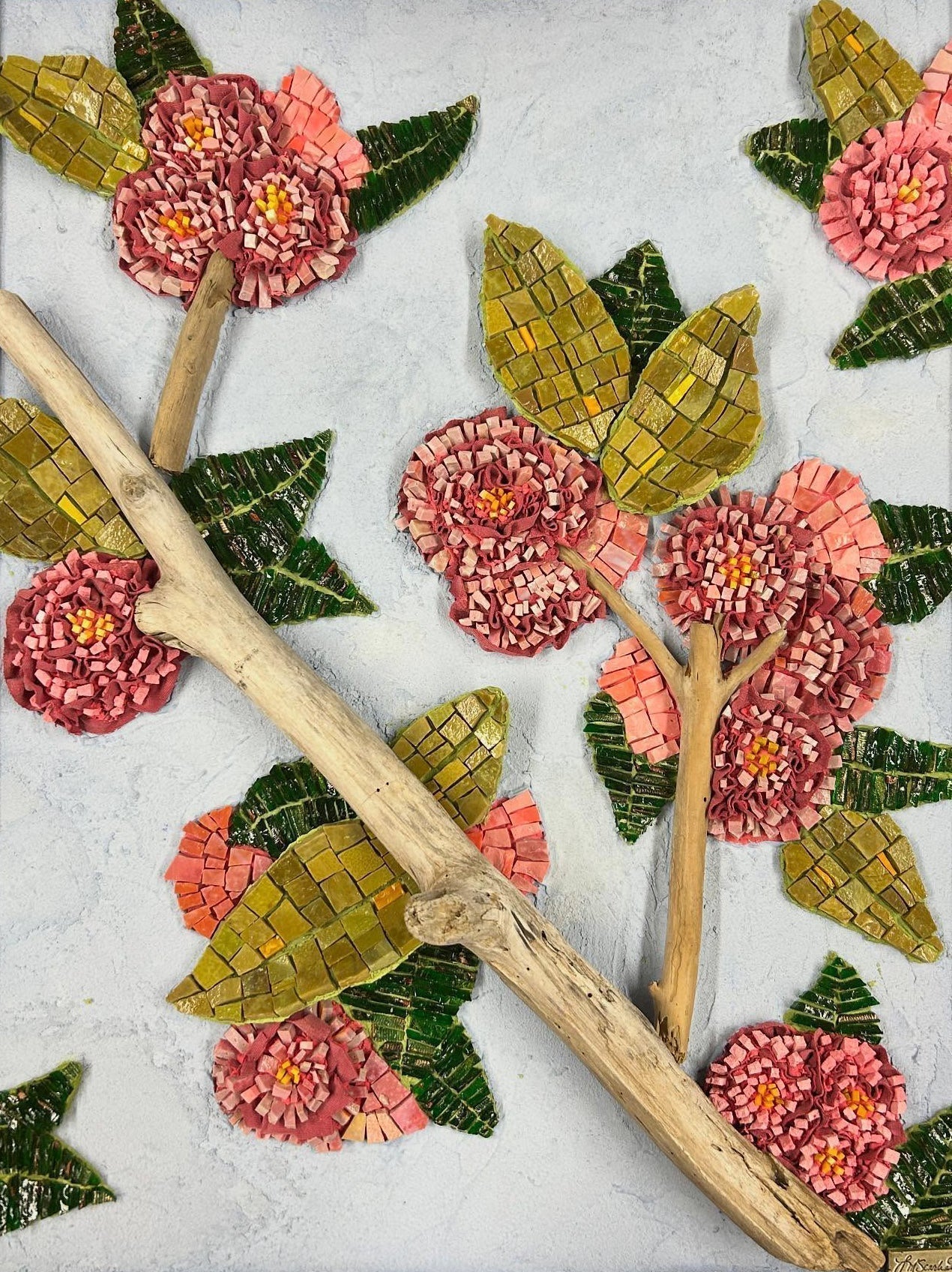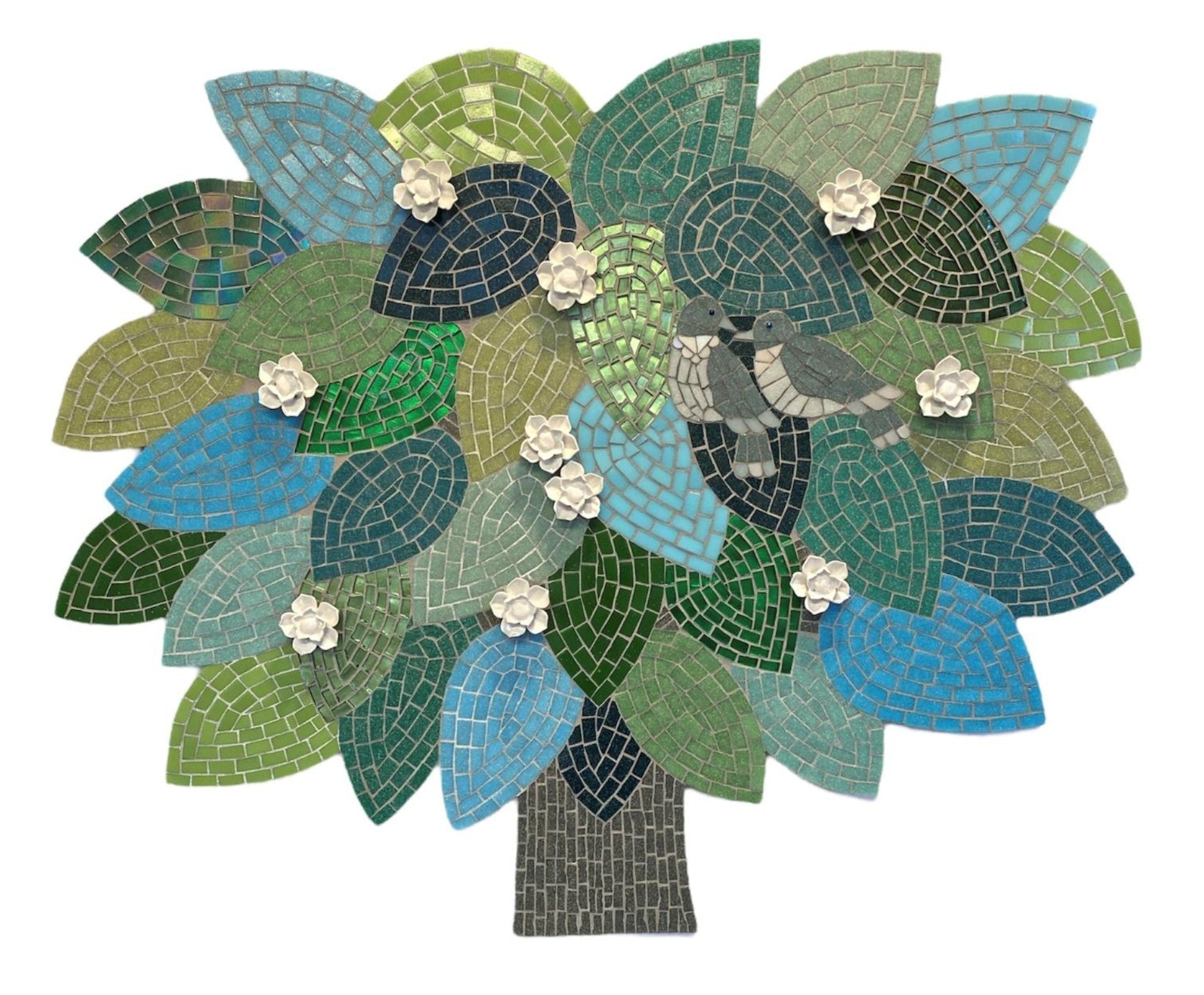


www.nodaysadhesives.com
www.instagram.com/kidsandglass
for her work with kids

LMA: Tell us a little about your artistic background:
Carrie: I’ve always enjoyed crafts and art projects. I started taking classes when I was in college, exploring drawing, mixed media, and painting and then I found glass as an offering at a junior college and was hooked. I apprenticed for a couple of different studios, working with furnace glass, as well as fused glass, stained glass, and mosaics, and any other technique that involved glass! Since then, I’ve joined a few different professional organizations, like SAMA, and take classes from instructors and artists I admire whenever I can.
LMA: Do you have any professional art training?
Carrie: I’ve taken art classes, but always for personal growth, not to acquire a degree.

2019 and 2018 SAMA 100 Moments in Mosaic Projects - Creating a series to explore various techniques using the same pattern
2019 piece all on edge in tinted thinset (except for the green leaves)
2018 piece - layered saw cut glass with 22k kiln fired gold painted edges
LMA: How did you get started in mosaics?
Carrie: I started working in glass in 2005, and was initially wooed by fused glass and the magic of the kiln. The studio where I took classes was a small business with the owner as the only employee. I wanted to be there as often as I could and help out, but initially had no skills to offer. So, I took every class that the owner offered in order to grow my skills enough to be valuable enough to help out around the studio and eventually started teaching some of the beginner classes. This was the studio where I first encountered mosaics, but it wasn’t until I started attending the American Mosaic Society annual conference as a vendor that I was exposed to mosaics in a way that made we want to explore the art form more.

 Glass on Glass Rose Window Commission
Glass on Glass Rose Window Commission
Leaded glass panel substrate lightbox
36"
2018
LMA: Did you start with mosaic or did you work in other mediums before working in mosaic?
Carrie: I took classes at a junior college to explore different forms of art. I took Voice classes, Guitar, Piano, Composition classes, Dance, Painting, Mixed Media and Drawing classes, as well as digital art classes. Basically, I am in love with all forms of art and was taking classes for personal growth and to make friends in a town I had moved to on my own.
When I found the glass studio, that is where I found the greatest sense of community and made friends that I still have to this day. I still enjoy other mediums and will occasionally work them into my glass and mosaic pieces, but more often than not, I will use those other mediums in teaching and my work with kids.

 Nebraska Landscape commissioned stained glass lightbox with glass on glass inclusions, fused glass and painted glass
Nebraska Landscape commissioned stained glass lightbox with glass on glass inclusions, fused glass and painted glass
2015
24" x 24"
LMA: What about mosaics resonates with you?
Carrie: I imagine that like many mosaic artists, the act of breaking apart and putting back together is a very meditative and healing process. Working on pattern and repetition or just getting lost and inspired by the pieces can be a great way to step away from the stresses that we run into in everyday life. Sometimes just playing with various colors is just the right distraction. One summer I worked on nothing but the same mandala pattern in different colors and varying the lines, dots and shapes.

Glass on Glass Mosaic Mandala - I have done a whole series of these pieces and enjoy the endless color combinations. This is a class I teach at the Glass Craft and Bead Expo and will be teaching at SAMA in January.
LMA: Do you have a favorite subject matter? What is it?
Carrie: I come back to flowers and leaves again and again. I was a horticulture major in college and studied plants and really looked at them closely during plant identification classes. We would have to identify a tree in the winter time by the bark, the buds, and the growth habit, which is definitely a practice in observation. I am also inspired by textile arts and techniques. My mother was a quilter and my grandmother crocheted and embroidered. I learned to quilt from my mother and made a few quilts for friends, but I choose to spend my time working with glass more than fabric. However, I will often use quilt blocks as inspiration, or emulate techniques and translate them into glass and mosaic.
 60" x 36", glass & mirror mosaic
60" x 36", glass & mirror mosaic

102" x 36", glass & mirror mosaic
LMA: What is your favorite thing you have created and why?
Carrie: My favorite creation so far is the glass dress I made for the Glass Art Society conference Glass Fashion Show in Murano in 2018. It was a fun challenge to come up with an idea for a dress and then have to puzzle out how to make it actually be wearable. A flat pattern doesn’t fit a curved body, but I was able to draw on yet another class I took at the Junior College, Pattern Drafting. I learned how to adjust patterns to fit bodies, and the knowledge of how that works led me to the technique I used to make the corset. It was an epic project with a deadline of less than 7 months. It was January before I had the substrate built, and all the pieces needed to be finished and ready to wear by May! It was a very introspective and personally challenging period in my life, so it was very healing for me to have a project I could throw myself into. The evening of the Fashion Show where the runway was boats in the canals of Murano was a once in a lifetime experience. (There will be another Glass Fashion Show in 2022, location to be determined, and I am currently working on adding more components to the outfit to make it even glassier!)
"Aceso Corset Dress"
2018 Glass Fashion Show piece for the Glass Art Society conference in Murano. I used smalti from the Mosaici Dona Murano Shop in my dress!
This dress was also exhibited in the SAMA Mosaic Arts International exhibition in Nashville in 2019
LMA: What made you want to participate in the Diversity Mural?
Carrie: I was honored to be able to contribute to the Diversity Mural. The collaborative effort shows the positive energy and intentions of the community to honor those who are affected by acts of injustice, not just the single event that prompted the response. Hopefully, the Diversity Mural stands as a beacon that emanates healing energies and helps to grow empathy and understanding so that we can all realize we are living our lives together and we are not so different from one another.

LMA: What is the meaning behind your heart you created for the Diversity Mural?
Carrie: I created several small fused glass candy hearts with messages asking for and offering love.




